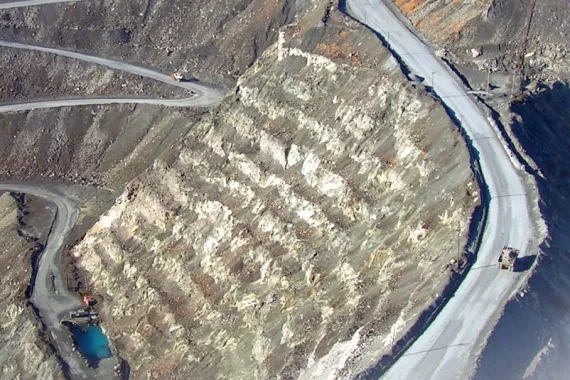
Case Overview
Asbestos and Canada have a long history that includes a once-booming asbestos mining industry. Asbestos workers and individuals exposed to products containing asbestos have an increased risk of illness. If you or someone you love was sickened by asbestos exposure, you may qualify for compensation.
Key takeaways about asbestos in Canada
- Asbestos is a naturally occurring fibrous mineral. It was once used in many common building materials and auto parts for its strength and fire-resistant properties. Asbestos was heavily mined in Canada until 2011.
- Asbestos in Canada was banned in 2018 because of health concerns. Asbestos exposure is linked to the development of asbestosis, lung cancer and mesothelioma.
- Motley Rice can help you seek justice if you or someone you love developed an asbestos-related illness after being exposed to asbestos at work or through asbestos-containing products. We have decades of experience litigating asbestos cases involving exposures that occurred in Canada and the United States.
What is asbestos, and how was it used in Canada?
Asbestos is a fibrous mineral that occurs naturally in rocks and soil. The strength of its fibers and their heat-resistant properties led to its widespread use in products to make them stronger, longer-lasting and fire-retardant. Asbestos was commonly used in Canada in building materials and automotive parts, including:
- Building insulation
- Car and truck brake pads
- Cement and plaster
- Home siding
- Industrial furnaces and heating systems
- Vehicle transmission components
Asbestos and Canada have a long history. The first asbestos mine opened in the country in 1878, and for over a century, asbestos mining in Canada was a significant industry. From 1990 to 2011, Canada exported over $4 billion in raw asbestos annually, primarily from the Thetford Mines and Asbestos, Quebec, recently renamed Val-des-Sources, Quebec.
Canadian miners began seeking compensation for asbestos-related diseases as early as the 1980s. The Canadian Environmental Protection Act (CEPA) List of Toxic Substances included all forms of asbestos in 1999. Despite health concerns and a decrease in domestic use, Canada did not stop mining or exporting asbestos until 2011. That year, the government estimated that asbestos was responsible for 1,900 lung cancer cases and 430 mesothelioma cases.
When did Canada ban asbestos?
Asbestos use in Canada has declined since the 1970s. The country began placing partial bans on some asbestos products in the early 1980s. However, it was not until 2016 that the Canadian government announced it would implement a full ban on asbestos and asbestos products. Asbestos regulations in Canada officially went into effect on December 30, 2018. Asbestos is no longer legal in Canada for most uses.
What is the scope of the ban?
The ban prohibits the “manufacture, use, sale, offer for sale, import and export” of asbestos and asbestos products. Canada’s asbestos law has some narrowly defined exceptions. These include its use in certain military and industrial operations. The ban also does not apply to the use of asbestos already integrated into structures, infrastructure and products before 2018.
Health risks of asbestos exposure
Asbestos has been classified as a known human carcinogen by several health and environmental organizations, including the International Agency for Research on Cancer (IARC). Long-term health risks of asbestos exposure include the following asbestos-related diseases:
- Asbestosis: Asbestosis is a chronic lung condition that causes scar-like tissue to form in the lungs. This condition is called pulmonary fibrosis. The most common symptom of asbestosis is shortness of breath. The condition usually develops after several years of exposure to asbestos fibers.
- Lung cancer: Studies find that workers with one to 12 months of exposure to asbestos have an increased risk for lung cancer. However, it may not develop for 20 to 30 years after the initial contact with the substance. Early-stage lung cancer usually has no symptoms (asymptomatic). By the time symptoms occur, the cancer is often advanced. Symptoms include shortness of breath, chronic cough, chest pain, weight loss and fever.
- Mesothelioma: Studies have found strong associations between occupational asbestos exposure and mesothelioma. Malignant mesothelioma is an aggressive, usually fatal cancer. It causes tumor growth in the lining of the pleural (lung), peritoneal (abdominal) and pericardial (heart) cavities. The condition occurs in asbestos workers more often than in the general population. It is also more common among family members of workers who may carry fibers home on their clothing, leading to household exposure. Symptoms of mesothelioma may not develop for 30 to 40 years after exposure.
Workers in the following asbestos occupations and trades have a high risk of exposure:
- Asbestos disposal workers
- Asbestos miners
- Asbestos processors (millers)
- Cement workers
- Construction workers
- Custodial workers who may come into contact with asbestos-containing building materials
- Heating trades workers
- Insulation workers
- Manufacturers of asbestos-containing products
- Marina and shipyard workers
- Plumbers and pipefitters
- Sheet metal workers
- Vehicle mechanics
Workers in these industries may also bring asbestos home, risking secondary asbestos exposure for their families.
Can people exposed in Canada file an asbestos claim in the U.S.?
Motley Rice attorneys have served as U.S. legal counsel for several workers’ compensation boards in Canada since 1987 regarding asbestos recovery efforts in the U.S.
In addition to our efforts with Canadian workers’ compensation boards, Motley Rice also files U.S. bankruptcy trust claims for Canadian citizens suffering from asbestos-related diseases who do not have workers’ compensation claims, including family members sickened by inhaling asbestos dust brought home by loved ones on their work clothes.
Historically, Motley Rice attorneys were involved in early litigation cases in Canada - Hunt v. T&N plc, [1993] 4 S.C.R. 289 and Amchem Products Incorporated v. British Columbia (Workers' Compensation Board), which helped to pave the way for Canadian cases to be litigated in the U.S. in the 1990s.
- U.S. asbestos bankruptcy trusts: Canadians exposed to asbestos through U.S. products may qualify for compensation through a U.S. bankruptcy trust fund. Canadian citizens are treated the same as U.S. citizens under the U.S. bankruptcy trusts. Motley Rice can determine if you are eligible and manage the complex filing process.
Our asbestos litigation experience
Motley Rice attorneys have decades of experience with asbestos litigation involving exposures that occurred in the U.S. and Canada. We provide education, support and legal advocacy to individuals and families harmed by asbestos exposure. If you or someone you love suffers from an asbestos-related illness, we can help you seek justice.
Our lawyers have been involved in the following asbestos-related lawsuits:
- Federal Employers Liability Act (FELA) claims
- Household asbestos exposure lawsuits
- Johns-Manville asbestos litigation
- MARDOC
- Talcum powder asbestos lawsuits
- Travelers Co. Asbestos-Related Settlements
Contact a Motley Rice asbestos lawyer to discuss your claim and learn more about asbestos and Canada. Complete our online form or call 1.800.768.4026.
Read more about our asbestos exposure litigation experience.
Key takeaways
What is asbestos, and how was it used in Canada?
When did Canada ban asbestos?
Health risks of asbestos exposure
Can people exposed in Canada file an asbestos claim in the U.S.?
Our asbestos litigation experience
- Sources
- Canadian Centre for Occupational Health and Safety. Asbestos.
- Canadian Labour Congress. Asbestos in Canada: A Timeline.
- Canadian Underwriter. Cover Story: Danger: Asbestos Exposures.
- CBC. Canada introduces new asbestos rules.
- Environmental Protection Agency. Learn About Asbestos.
- Government of Canada. Asbestos.
- Government of Canada. Asbestos in the home (infographic).
- Government of Canada. Prohibition of Asbestos and Products Containing Asbestos Regulations: frequently asked questions.
- MiningWatch Canada. Asbestos Mining in Canada.
- National Cancer Institute. Asbestos Exposure and Cancer Risk.
- Vancouver Sun. Asbestos has rich history in Canada.
Start Your Motley Rice Consultation in Simple Steps
Submit Information
Call us or fill out our online form with the details of your potential case.
Case Review
Our team reviews your information to assess your potential case.
Case Consultation
Talk with us about next steps.


